A Deposition Model: Riemann Problem and Flux-Function Limits of Solutions
Abstract
The Riemann solutions of a deposition model are shown. A singular flux-function limit of the obtained Riemann solutions is considered. As a result, it is shown that the Riemann solutions of the deposition model just converge to the Riemann solutions of the limit system, the scalar conservation law with a linear flux function involving discontinuous coefficient. Especially, for some initial data, the two-shock Riemann solution of the deposition model tends to the delta-shock Riemann solution of the limit system; by contrast, for some initial data, the two-rarefaction-wave Riemann solution of the deposition model tends to the vacuum Riemann solution of the limit system. Some numerical results exhibiting the formation processes of delta-shocks and vacuum states are presented.
1. Introduction
Let us recall some knowledge with respect to delta-shocks and vacuum states. Delta-shocks are an important kind of nonclassical wave for systems of conservation laws. Mathematically, they are characterized by the delta functions appearing in the state variables. Physically, they can describe the concentration phenomenon. As for delta-shocks, see [9–18]. The other extreme situation is the vacuum state. It describes the cavitation phenomenon. Recently, the phenomena of concentration and cavitation and the formation of delta-shock and vacuum state have attracted wide attention from researchers. For example, Li [19] and Chen and Liu [20, 21] discussed this topic by considering the vanishing pressure limits of solutions of the isentropic and nonisentropic Euler equations. With respect to this topic, also see [22–24].
The second task of this paper is to study the behaviors of solutions of system (1) as the flux ϵv vanishes (i.e., ϵ → 0+) by the Riemann problem. We are especially concerned with the phenomena of concentration and cavitation and the formation of delta-shocks and vacuum states in the limit. As a result, we rigorously show that as ϵ → 0+, the Riemann solutions of (1) just converge to the Riemann solutions of (3) with the same initial data. Especially, when u+ ⩽ 0 ⩽ u−, the two-shock solution of (1) and (2) tends to the delta-shock solution of (3) and (2), where the intermediate density between the two shocks tends to a weighted δ-measure which forms the delta-shock; by contrast, when u+⩾0⩾u−, the two-rarefaction-wave solution of (1) and (2) tends to the two-contact-discontinuity solution of (3) and (2), in which the nonvacuum intermediate state between the two rarefaction waves tends to a vacuum state. It can also be seen that such a flux-function limit may be very singular: the limit functions of solutions are no longer in the spaces of functions BV or L∞, and the space of Radon measures is a natural space in order to deal with such a limit.
The rest of the paper is organized as follows. In Section 2, we recall the Riemann problem for system (3). In Section 3, we solve the Riemann problem for (1) by the analysis method in phase plane. Sections 4 and 5 are devoted to the studies of the limits of solutions of the Riemann problem for (1) as ϵ → 0+. In Section 6, we present some numerical results to examine the formation processes of delta-shocks and vacuum states as ϵ decreases. Finally, we give the conclusions in Section 7.
2. Solutions of the Riemann Problem for (3)
In this section, we briefly recall the Riemann problem for (3) with initial data (2), for which we also refer the readers to the papers [6, 7]. The characteristic roots of (3) are λ1(u, v) = 0 and λ2(u, v) = u, and the corresponding right characteristic vectors are and , respectively. They satisfy , where, in what follows, ∇ = (∂/∂u, ∂/∂v) is the gradient operator. Therefore, (3) is nonstrictly hyperbolic because of λ1 = λ2 at u = 0, and λi (i = 1,2) is linearly degenerate.
- (1)
When u− > 0, u+ > 0, the solution is SW + J:
(8) - (2)
When u− < 0, u+ < 0, the solution is J + SW:
(9) - (3)
When u− ⩽ 0 ⩽ u+, the solution is J + Vac + J:
(10)
However, for the case u+ ⩽ 0 ⩽ u−, the singularity cannot be a jump with finite amplitude; that is, there is no solution which is piecewise smooth and bounded. Hence a solution containing a weighted δ-measure (i.e., delta-shock) supported on a line should be introduced in order to establish the existence in a space of measures from the mathematical point of view.
Denote by the space of bounded Borel measures on , then the definition of a measure solution of (3) in can be given as follows.
Definition 1. A pair (u, v)(x, t) is called a measure solution of (3) if it satisfies that
- (a)
- (b)
- (c)
u is measurable with respect to v almost for all t ≥ 0.
And (3) is satisfied in the measure and distributional senses; that is,
Remark 2. The continuity conditions in may be used to give an interpretation for (u, v)(x, t) to take on initial values [25].
Definition 3. A two-dimensional weighted delta function w(s)δL supported on a smooth curve L parameterized as x = x(s), t = t(s) (c ≤ s ≤ d) is defined by
A discontinuity in the form (13) satisfying (14) and (15) will be called a delta-shock, symbolized by δ.
Remark 4. Here the delta-shock is defined as a measure solution just as in [10, 17, 18, 25]. In fact, like [14, 15], it can also be defined as a solution in the sense of distributions, which gives a natural generalization of the classical definition of the weak L∞-solution and specifies the definition of measure solution.
Remark 5. Here in a delta-shock, we assign u to be uδ(t) on the discontinuity line. Physically, for instance, in adhesion particle dynamics, the formation of delta-shock can describe the process of the concentration of particles, and such an assignment can be interpreted as the velocity of colliding particles [17].
3. Solutions of the Riemann Problem for (1)
The discontinuity (36) with (42) is called a backward shock and symbolized by , and (37) with (42) is called a forward shock and symbolized by .
Denote and . Then the curve is monotonously decreasing, convex, and limu→−∞v = +∞; besides, it has the u-axis as the asymptote as Kl > 0 and interacts with the u-axis at as Kl ⩽ 0. The curve is monotonously increasing, convex, and limu→+∞v = +∞; besides, it has the u-axis as the asymptote as Mr > 0 and interacts with the u-axis at as Mr ⩽ 0.
We can construct the solutions of the Riemann problem by using the standard analysis method in the phase plane [26, 27]. Draw the backward wave curve passing the left state (u−, v−) and the forward wave curve passing the right state (u+, v+). According to the different locations of the intersection point of and , one can construct the unique global Riemann solution with five different structures as follows:
(i) a backward rarefaction wave + nonvacuum intermediate state + a forward rarefaction wave,
(ii) a backward rarefaction wave + nonvacuum intermediate state + a forward shock,
(iii) a backward shock + nonvacuum intermediate state + a forward rarefaction wave,
(iv) a backward shock + nonvacuum intermediate state + a forward shock,
(v) a backward rarefaction wave + vacuum intermediate state (v ≡ 0) + a forward rarefaction wave.
The conclusion can be stated in the following theorem.
4. Limits of Solution of (1) and (2) for u− > u+, u−v− > u+v+
In this section, we study the limits of solution of (1) and (2) as ϵ → 0+ for the case u− > u+, u−v− > u+v+. We especially pay more attention on the phenomenon of concentration and the formation of delta-shocks in the limit.
Lemma 7. If u− > u+, u−v− > u+v+, then there exists ϵ0 > 0 such that for any ϵ < ϵ0.
Proof. All states (u, v) connected with (u−, v−) by S1 or S2 satisfy
The following lemmas describe the limit behaviors of the intermediate state and the speeds of two shocks as ϵ → 0+.
Lemma 8. is monotonously decreasing with respect to ϵ.
Proof. From (49) and (50), we have the equation with respect to
Lemma 9. is monotonously increasing with respect to ϵ.
Proof. For ϵ1 > ϵ2, assume ; then we have , which contradicts with . Therefore, for ϵ1 > ϵ2, we must have .
Lemma 10. One has
Proof. When u− > u+ > 0, u−v− > u+v+ or 0 > u− > u+, u−v− > u+v+, assume ; then from (51), we have
Lemma 11. One has
Proof. Let . When u− > u+ > 0, u−v− > u+v+ or 0 > u− > u+, u−v− > u+v+, in virtue of Lemma 10, M = 0 is obvious. When u−⩾0⩾u+, from (51), one has
Lemma 12. One has
Proof. From the second equation in (50), we have
Lemma 13. One has
Lemma 14. One has
Thus we have the following result.
5. Limits of Solutions of (1) and (2) for u+⩾0⩾u−
In this section, we study the limits of solutions of (1) and (2) as ϵ → 0+ for the case u+⩾0⩾u− and show the phenomenon of cavitation and the formation of vacuum states in the limit.
Lemma 16. If u+⩾0⩾u−, then there exists ϵ1 > 0 such that for any ϵ < ϵ1.
Proof. If v+ = v−, ϵ1 may be taken as any real positive number. If v+ > v−, ϵ1 may be taken as the value of ϵ satisfying
Let and , which mean and . Denote ϵ2 = min{ϵ−, ϵ+}.
When ϵ1 > ϵ > ϵ2, the Riemann solution for (1) and (2) contains two rarefaction waves with a nonvacuum intermediate state. This implies that, for a larger ϵ, no vacuum occurs in the solution.
In Sections 4 and 5, we have proven that when u− > u+, u−v− > u+v+ or u+⩾0⩾u−, the limits of solutions of the Riemann problem for (1) just are the solutions of the Riemann problem for (3) with the same initial data. The same conclusions are true for the rest of the cases, and we omit the discussions.
6. Numerical Simulations
To understand the formation processes of delta-shocks and vacuum states in the Riemann solutions of (1) and (2) as the flux ϵv vanishes, we present some representative numerical results. To discretize the system, we employ the Nessyahu-Tadmor scheme [28] with 500 cells and CFL = 0.475.

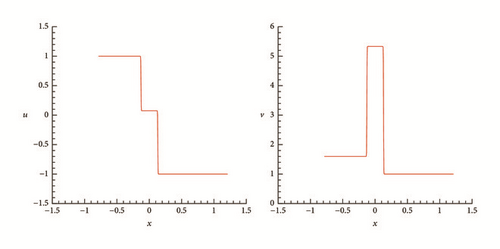
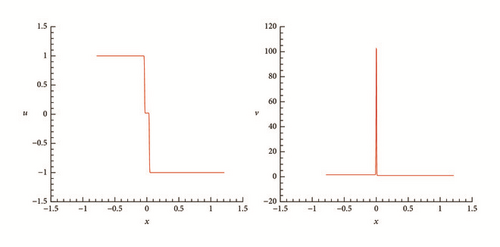
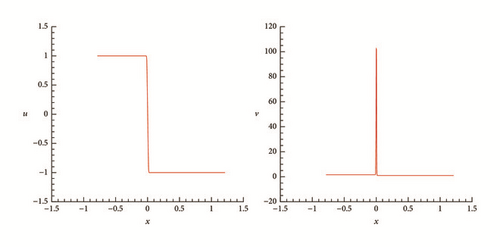
One can observe clearly from these numerical results that, when ϵ decreases, the location of the two shocks becomes closer and closer, and the density of the intermediate state increases dramatically, while the velocity is closer to a step function. The numerical simulations are in complete agreement with the theoretical analysis in Section 4.
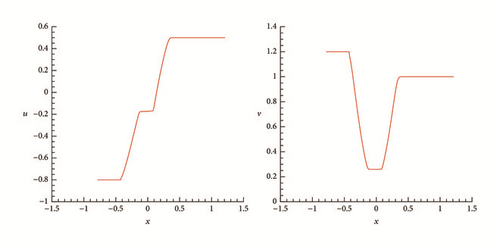
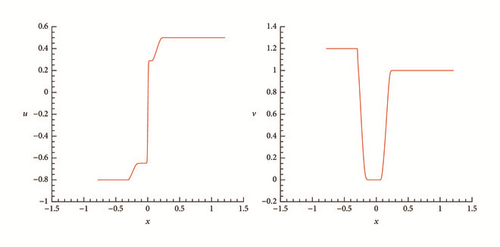
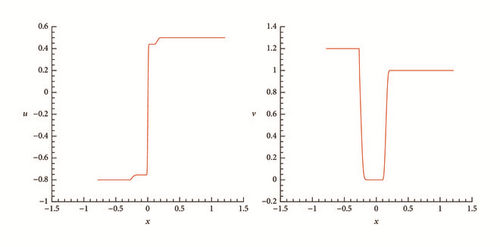
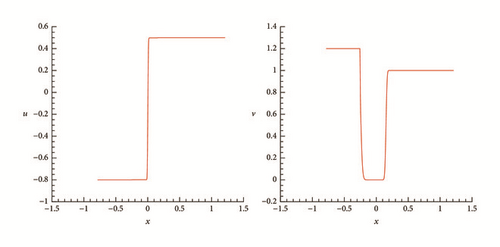
One can see that when ϵ = 0.6, the vacuum does not appear; when ϵ = 0.1, the vacuum appears; when ϵ decreases to zero, the two rarefaction waves become two contact discontinuities. The numerical simulations are also in complete agreement with the theoretical analysis in Section 5.
7. Conclusions and Discussions
In this paper, we consider (93) for the case γ = 0, that is, model (1), which arose in the context of the true self-repelling motion constructed by Toth and Werner [1]. Firstly, we solve the Riemann problem, which is very useful for the understanding of equations because all properties, such as shocks and rarefaction waves, appear as characteristics in the solution. By the analysis method in phase plane, we obtain five kinds of structures of solutions containing shock(s) and/or rarefaction wave(s). Secondly, we consider the flux-function limits of solutions of system (1). We prove that the Riemann solutions of system (1) just converge to the Riemann solutions of the limit system (3). We especially identify and analyze the formation of delta-shocks and vacuum states in the limit.
For (93), the parameter γ is of crucial importance: different values of γ lead to completely different behaviors. One can carry out the investigation similar to that in this paper for some other cases, such as γ = 1 (Leroux equation) and γ = 1/2 (shallow water equation).
Conflicts of Interest
The authors declare that there are no conflicts of interest regarding the publication of this paper.
Acknowledgments
This work is supported by Applied Basic Research Projects of Yunnan Province (2015FB104).




